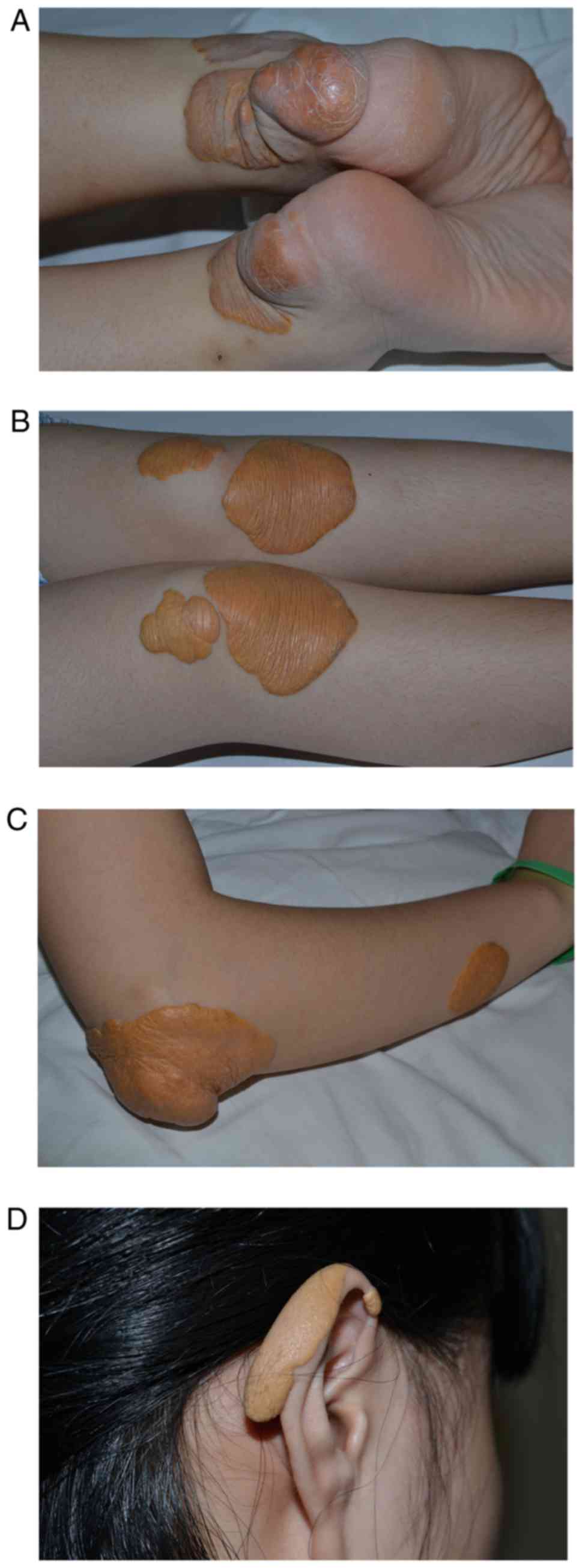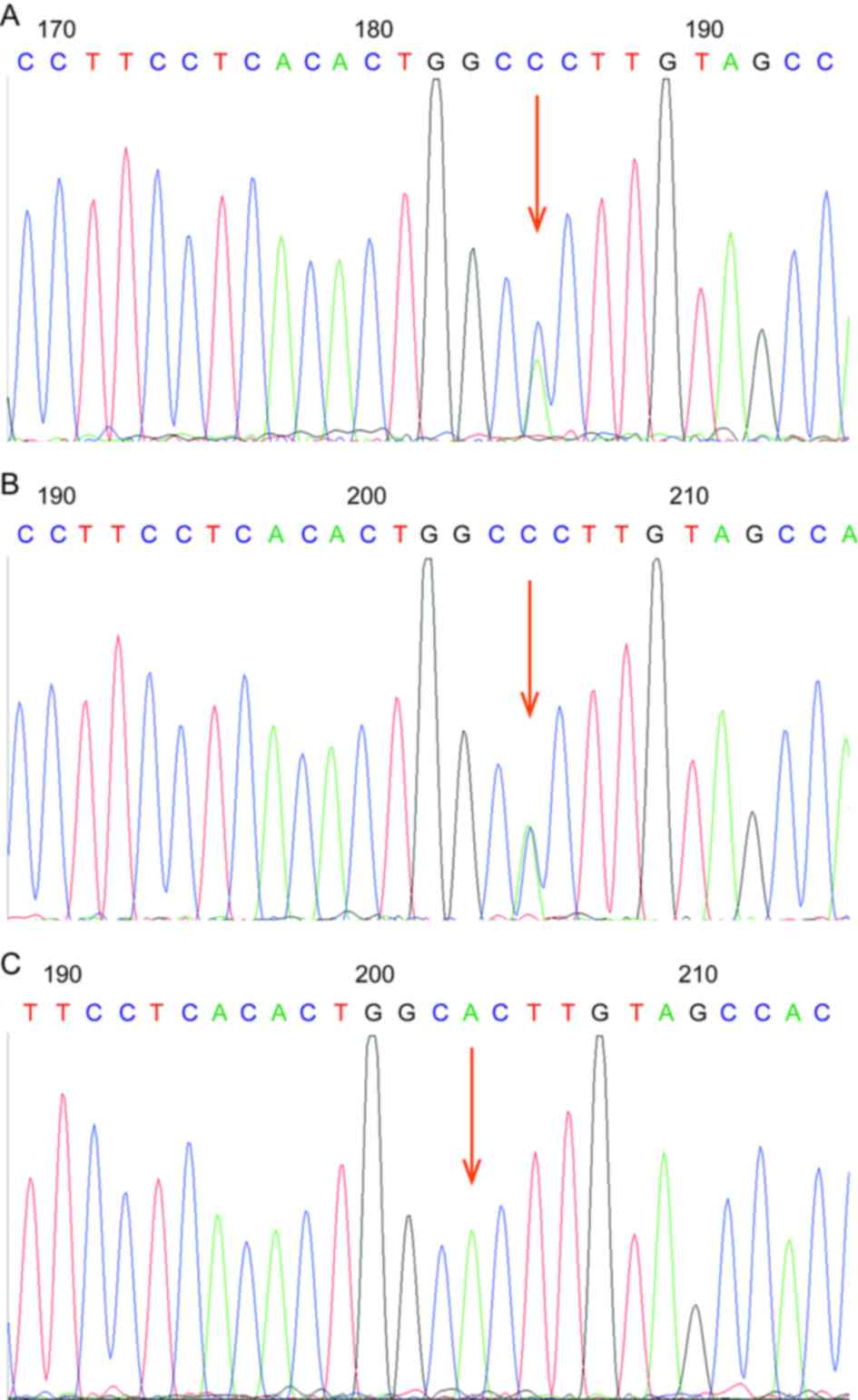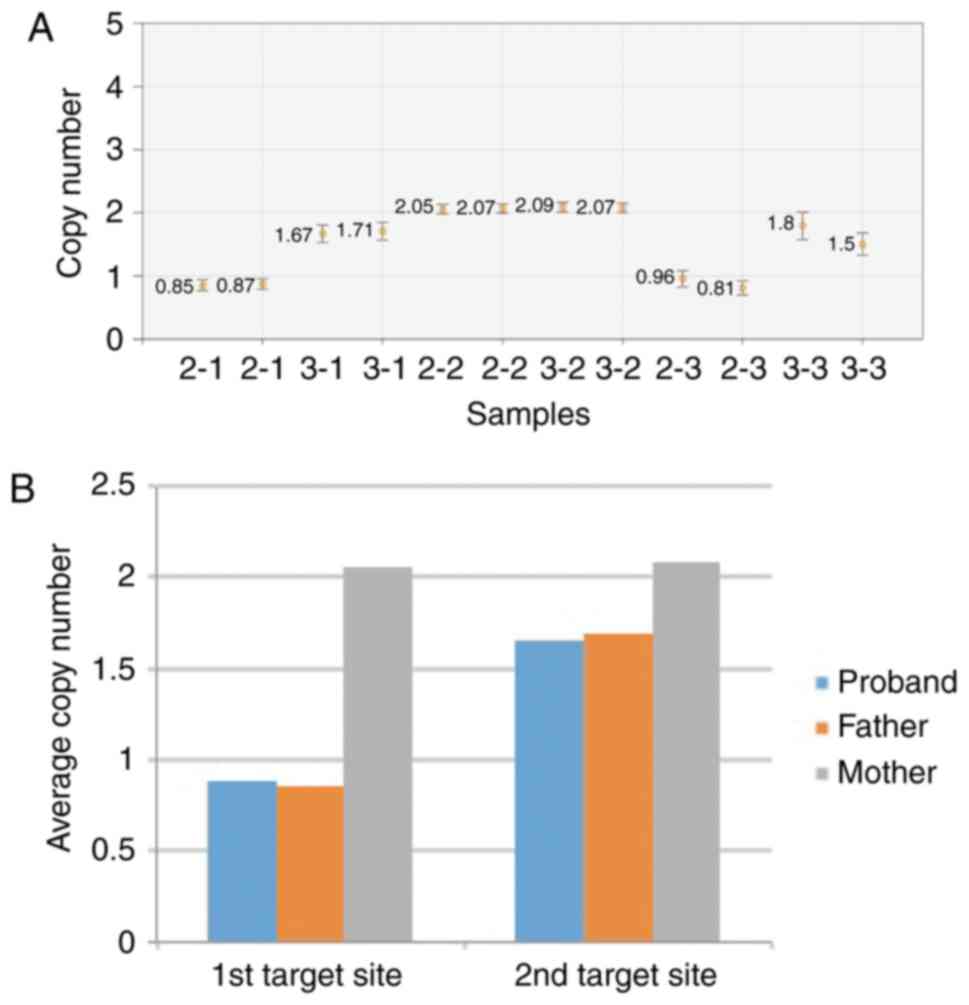|
1
|
Raal FJ and Santos RD: Homozygous familial
hypercholesterolemia: Current perspectives on diagnosis and
treatment. Atherosclerosis. 223:262–268. 2012. View Article : Google Scholar : PubMed/NCBI
|
|
2
|
Goldstein JL, Hobbs HH and Brown MS:
Familial hypercholesterolemiaThe metabolic basis of inherited
disease. McGraw-Hill; New York: pp. 2863–2913. 2001
|
|
3
|
Wang L, Lin J, Liu S, Cao S, Liu J, Yong
Q, Yang Y, Wu B, Pan X, Du L, et al: Mutations in the LDL receptor
gene in four Chinese homozygous familial hypercholesterolemia
phenotype patients. Nutr Metab Cardiovasc Dis. 19:391–400. 2009.
View Article : Google Scholar : PubMed/NCBI
|
|
4
|
Hooper AJ, Nguyen LT, Burnett JR, Bates
TR, Bell DA, Redgrave TG, Watts GF and van Bockxmeer FM: Genetic
analysis of familial hypercholesterolaemia in Western Australia.
Atherosclerosis. 224:430–434. 2012. View Article : Google Scholar : PubMed/NCBI
|
|
5
|
Jiang L, Sun LY, Dai YF, Yang SW, Zhang F
and Wang LY: The distribution and characteristics of LDL receptor
mutations in China: A systematic review. Sci Rep. 5:172722015.
View Article : Google Scholar : PubMed/NCBI
|
|
6
|
Humphries SE, Norbury G, Leigh S, Hadfield
SG and Nair D: What is the clinical utility of DNA testing in
patients with familial hypercholesterolaemia? Curr Opin Lipidol.
19:362–368. 2008. View Article : Google Scholar : PubMed/NCBI
|
|
7
|
Taylor A, Wang D, Patel K, Whittall R,
Wood G, Farrer M, Neely RD, Fairgrieve S, Nair D, Barbir M, et al:
Mutation detection rate and spectrum in familial
hypercholesterolaemia patients in the UK pilot cascade project.
Clin Genet. 77:572–580. 2010. View Article : Google Scholar : PubMed/NCBI
|
|
8
|
Lombardi MP, Redeker EJ, van Gent DH,
Smeele KL, Weerdesteijn R and Mannens MM: Molecular genetic testing
for familial hypercholesterolemia in the Netherlands: A stepwise
screening strategy enhances the mutation detection rate. Genet
Test. 10:77–84. 2006. View Article : Google Scholar : PubMed/NCBI
|
|
9
|
Poncz M, Solowiejczyk D, Harpel B, Mory Y,
Schwartz E and Surrey S: Construction of human gene libraries from
small amounts of peripheral blood: Analysis of beta-like globin
genes. Hemoglobin. 6:27–36. 1982. View Article : Google Scholar : PubMed/NCBI
|
|
10
|
Belgrader P, Tanner SC, Regan JF, Koehler
R, Hindson BJ and Brown AS: Droplet digital PCR measurement of HER2
copy number alteration in formalin-fixed paraffin-embedded breast
carcinoma tissue. Clin Chem. 59:991–994. 2013. View Article : Google Scholar : PubMed/NCBI
|
|
11
|
Hindson BJ, Ness KD, Masquelier DA,
Belgrader P, Heredia NJ, Makarewicz AJ, Bright IJ, Lucero MY,
Hiddessen AL, Legler TC, et al: High-throughput droplet digital PCR
system for absolute quantitation of DNA copy number. Anal Chem.
83:8604–8610. 2011. View Article : Google Scholar : PubMed/NCBI
|
|
12
|
Livak KJ and Schmittgen TD: Analysis of
relative gene expression data using real-time quantitative PCR and
the 2(-Delta Delta C(T)) method. Methods. 25:402–408. 2001.
View Article : Google Scholar : PubMed/NCBI
|
|
13
|
Hartgers ML, Ray KK and Hovingh GK: New
approaches in detection and treatment of familial
hypercholesterolemia. Curr Cardiol Rep. 17:1092015. View Article : Google Scholar : PubMed/NCBI
|
|
14
|
Watts GF, Sullivan DR, Poplawski N, van
Bockxmeer F, Hamilton-Craig I, Clifton PM, O'Brien R, Bishop W,
George P, Barter PJ, et al: Familial hypercholesterolaemia: A model
of care for Australasia. Atheroscler Suppl. 12:221–263. 2011.
View Article : Google Scholar : PubMed/NCBI
|
|
15
|
Harada-Shiba M, Arai H, Oikawa S, Ohta T,
Okada T, Okamura T, Nohara A, Bujo H, Yokote K, Wakatsuki A, et al:
Guidelines for the management of familial hypercholesterolemia. J
Atheroscler Thromb. 19:1043–1060. 2012. View Article : Google Scholar : PubMed/NCBI
|
|
16
|
Williams RR, Hunt SC, Schumacher MC,
Hegele RA, Leppert MF, Ludwig EH and Hopkins PN: Diagnosing
heterozygous familial hypercholesterolemia using new practical
criteria validated by molecular genetics. Am J Cardiol. 72:171–176.
1993. View Article : Google Scholar : PubMed/NCBI
|
|
17
|
Watts GF, Gidding S, Wierzbicki AS, Toth
PP, Alonso R, Brown WV, Bruckert E, Defesche J, Lin KK, Livingston
M, et al: Integrated guidance on the care of familial
hypercholesterolaemia from the International FH Foundation:
Executive summary. J Atheroscler Thromb. 21:368–374.
2014.PubMed/NCBI
|
|
18
|
Nordestgaard BG, Chapman MJ, Humphries SE,
Ginsberg HN, Masana L, Descamps OS, Wiklund O, Hegele RA, Raal FJ,
Defesche JC, et al: Familial hypercholesterolaemia is
underdiagnosed and undertreated in the general population: Guidance
for clinicians to prevent coronary heart disease: Consensus
statement of the European Atherosclerosis Society. Eur Heart J.
34:a3478–a3490. 2013. View Article : Google Scholar
|
|
19
|
Tybjaerg-Hansen A and Humphries SE:
Familial defective apolipoprotein B-100: A single mutation that
causes hypercholesterolemia and premature coronary artery disease.
Atherosclerosis. 96:91–107. 1992. View Article : Google Scholar : PubMed/NCBI
|
|
20
|
Abifadel M, Varret M, Rabès JP, Allard D,
Ouguerram K, Devillers M, Cruaud C, Benjannet S, Wickham L, Erlich
D, et al: Mutations in PCSK9 cause autosomal dominant
hypercholesterolemia. Nat Genet. 34:154–156. 2003. View Article : Google Scholar : PubMed/NCBI
|
|
21
|
van der Graaf A, Avis HJ, Kusters DM,
Vissers MN, Hutten BA, Defesche JC, Huijgen R, Fouchier SW, Wijburg
FA, Kastelein JJ and Wiegman A: Molecular basis of autosomal
dominant hypercholesterolemia: Assessment in a large cohort of
hypercholesterolemic children. Circulation. 123:1167–1173. 2011.
View Article : Google Scholar : PubMed/NCBI
|
|
22
|
Lindgren V, Luskey KL, Russell DW and
Francke U: Human genes involved in cholesterol metabolism:
Chromosomal mapping of the loci for the low density lipoprotein
receptor and 3-hydroxy-3-methylglutaryl-coenzyme A reductase with
cDNA probes. Proc Natl Acad Sci USA. 82:8567–8571. 1985. View Article : Google Scholar : PubMed/NCBI
|
|
23
|
Yamamoto T, Davis CG, Brown MS, Schneider
WJ, Casey ML, Goldstein JL and Russell DW: The human LDL receptor:
A cysteine-rich protein with multiple Alu sequences in its mRNA.
Cell. 39:27–38. 1984. View Article : Google Scholar : PubMed/NCBI
|
|
24
|
Wu WF, Sun LY, Pan XD, Yang SW and Wang
LY: Use of targeted exome sequencing in genetic diagnosis of
Chinese familial hypercholesterolemia. PLoS One. 9:e946972014.
View Article : Google Scholar : PubMed/NCBI
|
|
25
|
Rødningen OK, Tonstad S, Ose L, Berg K and
Leren TP: Effects of a 9.6-kb deletion of the LDL receptor gene (FH
Helsinki) on structure and levels of mRNA. Hum Mutat. 12:95–102.
1998. View Article : Google Scholar : PubMed/NCBI
|
|
26
|
Rødningen OK, Røsby O, Tonstad S, Ose L,
Berg K and Leren TP: A 9.6 kilobase deletion in the low density
lipoprotein receptor gene in Norwegian familial
hypercholesterolemia subjects. Clin Genet. 42:288–295. 1992.
View Article : Google Scholar : PubMed/NCBI
|
|
27
|
Ooi EM, Barrett PH and Watts GF: The
extended abnormalities in lipoprotein metabolism in familial
hypercholesterolemia: Developing a new framework for future
therapies. Int J Cardiol. 168:1811–1818. 2013. View Article : Google Scholar : PubMed/NCBI
|
|
28
|
Gagné C, Gaudet D and Bruckert E:
Ezetimibe Study G: Efficacy and safety of ezetimibe coadministered
with atorvastatin or simvastatin in patients with homozygous
familial hypercholesterolemia. Circulation. 105:2469–2475. 2002.
View Article : Google Scholar : PubMed/NCBI
|
|
29
|
Thompson GR, Catapano A, Saheb S,
Atassi-Dumont M, Barbir M, Eriksson M, Paulweber B, Sijbrands E,
Stalenhoef AF and Parhofer KG: Severe hypercholesterolaemia:
Therapeutic goals and eligibility criteria for LDL apheresis in
Europe. Curr Opin Lipidol. 21:492–498. 2010. View Article : Google Scholar : PubMed/NCBI
|
|
30
|
Smilde TJ, van Wissen S, Wollersheim H,
Trip MD, Kastelein JJ and Stalenhoef AF: Effect of aggressive
versus conventional lipid lowering on atherosclerosis progression
in familial hypercholesterolaemia (ASAP): A prospective,
randomised, double-blind trial. Lancet. 357:577–581. 2001.
View Article : Google Scholar : PubMed/NCBI
|
|
31
|
Versmissen J, Oosterveer DM, Yazdanpanah
M, Defesche JC, Basart DC, Liem AH, Heeringa J, Witteman JC,
Lansberg PJ, Kastelein JJ and Sijbrands EJ: Efficacy of statins in
familial hypercholesterolaemia: A long term cohort study. BMJ.
337:a24232008. View Article : Google Scholar : PubMed/NCBI
|
|
32
|
Raal FJ, Pilcher GJ, Panz VR, van Deventer
HE, Brice BC, Blom DJ and Marais AD: Reduction in mortality in
subjects with homozygous familial hypercholesterolemia associated
with advances in lipid-lowering therapy. Circulation.
124:2202–2207. 2011. View Article : Google Scholar : PubMed/NCBI
|
|
33
|
Thompson GR: The evidence-base for the
efficacy of lipoprotein apheresis in combating cardiovascular
disease. Atheroscler Suppl. 14:67–70. 2013. View Article : Google Scholar : PubMed/NCBI
|
|
34
|
Wiegman A, Gidding SS, Watts GF, Chapman
MJ, Ginsberg HN, Cuchel M, Ose L, Averna M, Boileau C, Borén J, et
al: Familial hypercholesterolaemia in children and adolescents:
Gaining decades of life by optimizing detection and treatment. Eur
Heart J. 36:2425–2437. 2015. View Article : Google Scholar : PubMed/NCBI
|
|
35
|
Cuchel M, Bruckert E, Ginsberg HN, Raal
FJ, Santos RD, Hegele RA, Kuivenhoven JA, Nordestgaard BG, Descamps
OS, Steinhagen-Thiessen E, et al: Homozygous familial
hypercholesterolaemia: New insights and guidance for clinicians to
improve detection and clinical management. A position paper from
the Consensus Panel on Familial Hypercholesterolaemia of the
European Atherosclerosis Society. Eur Heart J. 35:2146–2157. 2014.
View Article : Google Scholar : PubMed/NCBI
|


















